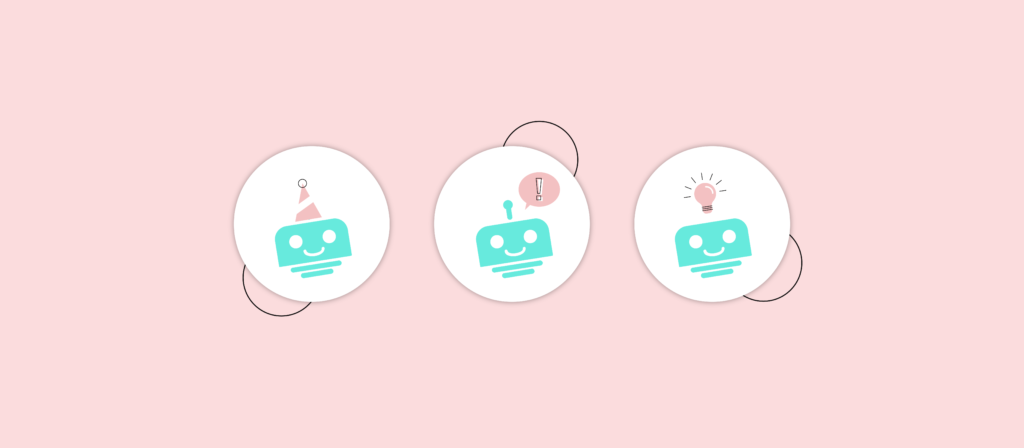As more and more employees work remotely, they’re undoubtedly experiencing a number of challenges.
New hires may have trouble getting up to speed; team members may experience difficulty building rapport; and employees may generally feel uncomfortable asking their colleagues questions.
To help address these challenges, and many others, you can turn to human resources (HR) chatbots. They can not only answer frequently asked questions, but also automate routine tasks, allowing the HR team to focus more on important tasks like strategic planning. In fact, HR chatbots have become an integral part of employee management, with studies suggesting that 62 percent of employees prefer to use a chatbot for their HR needs.
We’ll review 7 HR chatbots that can help, but before we do, let’s take a step back and align on what they are and how using one can up-level employee engagement.
What is an HR chatbot?
It’s a type of chatbot that can be used as part of an HR-related workflow automation. More specifically, it allows employees to access information and actions from their applications through a conversational interface in your business communications platform (e.g. Slack).
It’s easy to confuse HR chatbots with IT chatbots especially because both help streamline operations and allow employees to access data and interact with different applications without leaving their preferred business communication platform, but both have different purposes. An IT chatbot can handle a number of IT-related tasks, including allowing employees to request access to apps and scheduling visits to the office. Meanwhile, HR chatbots are more for HR-related tasks and can help answer questions employees may have, help onboard new hires, make it easy to submit referrals, etc.

There are two kinds of HR chatbots: rule-based and AI chatbots. A rule-based chatbot operates on pre-defined rules and patterns and is designed for specific tasks such as guiding users through a process or answering frequently asked questions. Unlike AI-based chatbots, they don’t learn from their interactions. Instead, they use decision trees to navigate through different conversations.
On the other hand, AI chatbots use machine learning and NLP (Natural Language Processing) to interact with customers and give more personalized responses. HR chatbots that leverage NLP promise a number of benefits. They can understand and communicate better, automate actions, leverage conversational search, and analyze documents to provide more accurate answers to employees. They can also be used for many other tasks such as conducting surveys and collecting feedback, and can help the HR team with day-to-day operations and the hiring process. AI-powered HR chatbots can also help digitize recruitment and significantly improve workflows.
Related: What is an IT chatbot?
How an HR chatbot can improve employee engagement
This type of chatbot generally offers 3 benefits for your employees:

- It centralizes your tools. Your employees don’t have to login to individual apps to do their work. They can simply use the messaging platform they’re already on—like Slack, Teams, or Workplace—to access and use any app.
- It helps colleagues meet one another. This not only applies to new employees who are looking to get acquainted with those in and outside of their team, but also longer-tenured employees who may be looking to connect with others.
- It puts the employee experience first. By allowing employees to avoid app-hopping, giving them convenient access to information, and enabling them to celebrate and connect with one another, chatbots can help your organization provide a first-rate employee experience.
HR chatbots are a strategic investment for businesses and more and more companies have been investing in them because they provide the following benefits:
- They offer significant cost savings. HR chatbots can handle a number of tasks that are otherwise delegated to the HR team. By managing routine processes and inquiries and automating tasks, chatbots reduce the need for a big HR team. As a result, they help save significantly in terms of training, recruitment costs, and other related expenses.
- They’re ideal for growing businesses. Chatbots can handle increasing workloads and adapt to changing HR policies without incurring any extra costs.
- They improve efficiency of operations. HR chatbots can automate and expedite tasks that are typically very time-consuming like onboarding and recruitment. For instance, it can take HR employees days to sort through different resumes, but a chatbot can do it in hours, significantly reducing time to hire and improving overall efficiency.

HR Chatbot Features to Look For
Using a ‘Job Application Template’ with chatbots in recruitment streamlines the hiring process and makes the process of handling applications more efficient. But to make the most out of these benefits, you need to consider the following key features.
- Screen candidates. The chatbot should be able to conduct initial screenings and ask applicants about their experience and qualifications to determine if they meet the requirements.
- Help fill out forms. The HR chatbot should help applicants fill out the application form and ensure all required fields are completed. It should also be able to validate inputs in real-time.
- Schedule interviews. It should schedule the applicant’s interview with hiring managers to reduce scheduling conflicts and save time.
- Update candidates on application status. It should offer applicants real-time updates on their application status and the next steps in the recruitment process.
Top HR Chatbots
Now that you know the benefits of HR chatbots and the features you should look out for, here are some of the top HR chatbots of today.
- Mya: Mya automates candidate screening and interview scheduling, saving HR professionals time and improving efficiency. It can also integrate with application tracking systems to further assist with talent acquisition.
- Bloomfire: This knowledge-sharing system helps organizations organize and share information such as documents and presentations internally. It serves as a central repository and with features like content categorization and search functionality, it makes it easier for employees to get the information they need.
- Xor: Xor helps automate the recruitment process and reduces time to hire. In addition to conducting the initial screening, it also helps create job listings and source candidates.
- Eightfold: This bot uses AI and machine learning to provide insights and solutions for workforce planning and talent acquisition. It identifies employee skill gaps and matches candidates to the most relevant jobs.
- Hirevue: Hirevue uses video technology and AI to streamline the whole hiring process. With this bot, organizations can conduct interviews remotely to eliminate geographical barriers.
Popular Slack integrations
HR Chatbot Use-Cases
1. Help employees find info independently with Knowledge Bot
Your colleagues likely share a variety of straightforward questions that need to get addressed quickly. These questions fall under topics like:

Instead of forcing certain employees to answer the same questions time and time again, or having employees comb through the knowledge base every time they need help, you can use Knowledge Bot.
Here’s how Knowledge Bot works:
1. When an employee has an issue or question, they can visit Knowledge Bot in their organization’s messaging platform.
2. The employee then has the option of inputting the category issue (e.g. Information Technology) and adding anything related to their issue or question under Search Term
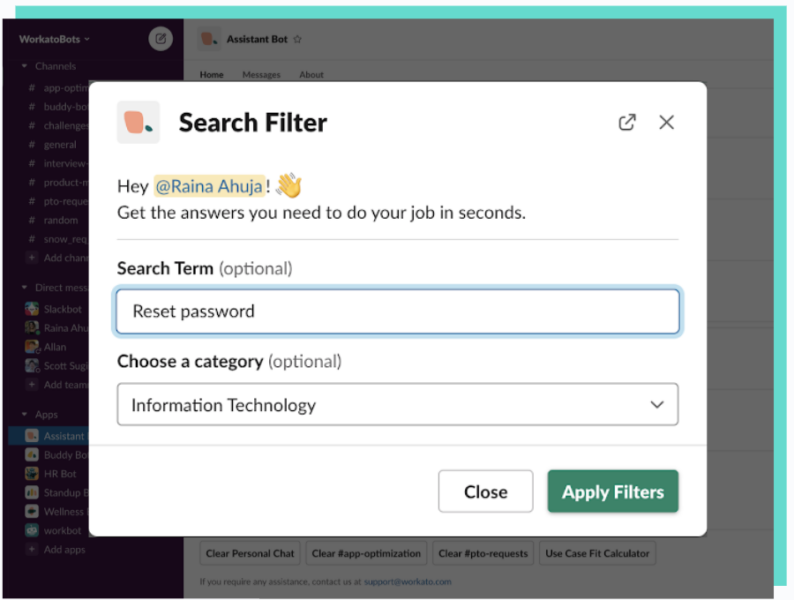
3. Once the employee hits Apply Filters, Knowledge Bot searches through all of the content across your organization’s knowledge bases in real time, whether it’s Guru, Confluence, Zendesk, etc., and it surfaces a few relevant articles for the employee.
4. The employee can then click on one of the article links to visit its page.
Related: How service desk chatbots can benefit your employees
2. Onboard new hires more easily with Welcome Bot
When a new hire comes onboard, they’ll likely need help with identifying the channels they should join within your organization’s messaging platform. This is all the more true if they’re working remotely, as the messaging platform can serve as their all-in-one place for uncovering valuable job-specific information and interacting with colleagues.
Welcome Bot can help take the load off of your HR department and hiring managers by sending a message to the new hire on their first day that:
- Asks them to introduce themselves to the wider team in a specific channel
- Shares channels that are specific to their area of interest
- Presents additional channels that can help the new hire stay up-to-date on all kinds of company information
- Offers channels where they can take part in fun and casual conversations
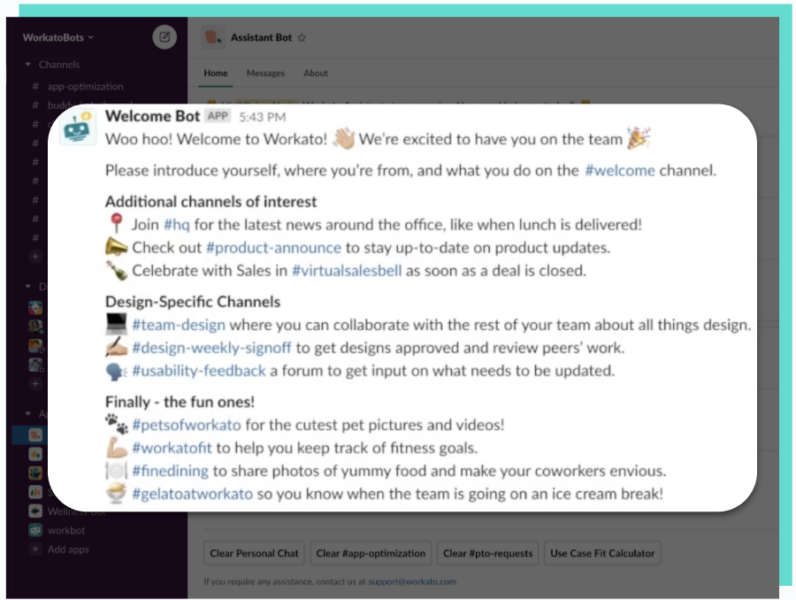
On the second day, Welcome Bot can help onboard the new hire even further by sharing a message that:
- Reminds the new hire to introduce themself to the company
- Tells the new hire about key contacts at the organization
- Presents specific resources that the new hire should know about
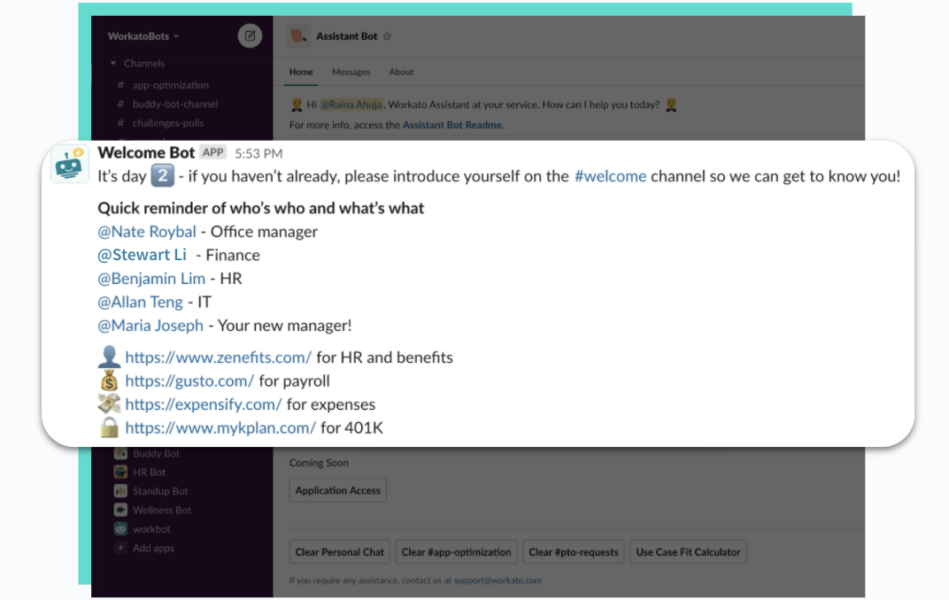
Related: Examples of using HR automation to improve recruiting and employee engagement
3. Wish colleagues a happy birthday in a way that’s thoughtful with Birthday Bot
When employees work remotely, your options for celebrating their birthdays are inherently limited. But you can still recognize their big day and make it better with Birthday Bot.
Using the HR chatbot, you’ll learn when a birthday from one of your team members is approaching, and you’ll get an opportunity to craft a message for them well in advance.
Once the team member’s birthday arrives, Birthday Bot takes all of the messages from the team and shares it directly with the employee.

Related: How helpdesk automation can help you deliver better employee experiences
4. Empower employees to submit referrals with Recruiter Bot
Allowing employees to refer former colleagues and friends doesn’t just benefit them: Research proves that referred employees are more likely to stay at a company for longer and perform better.
To encourage employees to submit referrals, you can enlist the help of RecruiterBot. The HR chatbot allows employees to submit referrals by providing a modal in your business communications platform that includes all of the required referral fields from your ATS; once filled out and submitted, the bot adds the candidate to your ATS.
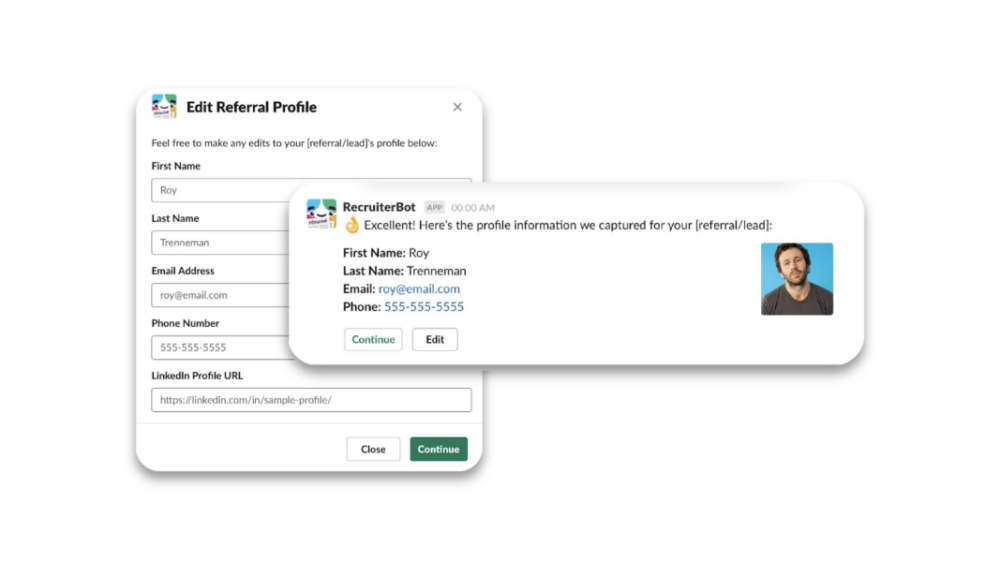
The team over at Slack uses Recruiter Bot and shared the significant results it’s delivered in their recruitment efforts.
Related: 5 internal chatbots worth implementing
5. Connect with team members and understand what they’re working on with Standup Bot
Given that many of your team members likely work remotely, it’s easy to feel disconnected from them and their work.
You can mitigate this feeling and bring your teams closer together by using Standup Bot.
Here’s how it can work: The bot asks each member of your team a specific set of questions every morning, such as “How are you feeling this morning?” and “What are your 3 most important tasks for today?” and “Any roadblocks or questions?”
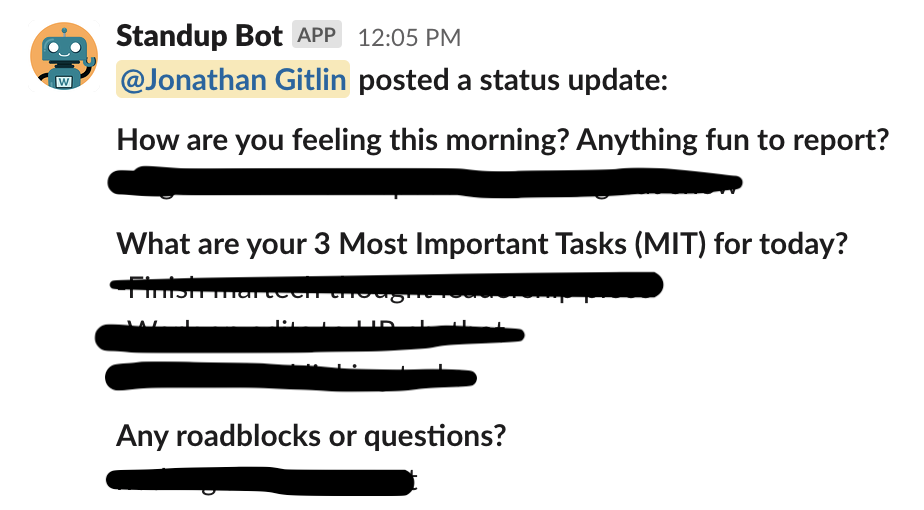
Once you’ve submitted your answers, Standup Bot posts them in your team’s channel within your business communications platform, allowing everyone on your team to see how you’re doing and what you’re working on—and they can respond accordingly.
6. Fast-track vacation requests and approvals with HR Bot
Numerous studies prove that vacations benefit both employees and your organization.
You can help employees (and your organization) reap these benefits by making the process of requesting time off easy through HR Bot.
Using the bot, employees can request paid time off through a simple command (e.g. “request time off”). HR Bot then prompts them to provide the specific days they’d like to take off and the reason they’d like to take that time off; once submitted, HR Bot quickly confirms that the requested days off don’t exceed the employee’s time off balance according to your HRIS. Assuming it doesn’t, the bot goes on to share the request with the requestor’s manager. The manager can reject or approve the request with the click of a button in your business communications platform, and whatever they decide, HR bot goes on to notify the requestor in real-time (this decision also gets reflected in your HRIS).
Related: How “Osiris Bot” streamlined Persefoni’s job requisition workflow
7. Enable employees to submit expenses with ease by using Benefits Bot
Your organization likely has allotted budgets for various types of benefits, whether it’s related to your employees’ home office, wellness, or education.
You can help employees submit expenses for any one of these benefits, track their status of any claim, and see how much they’ve expensed (as well as their remaining balance) for a given type of benefit with Benefits Bot.
On the bot’s homepage, the employee can view the variety of benefits available to them. They can then go on to submit a claim with the simple click of a button (e.g. “Put in a new claim”).

This prompts the bot to ask the employee for all the information that’s required, such as a description of the item that was purchased, the amount to claim, and a screenshot of the receipt. Once submitted, the bot posts the claim to the appropriate channel in your business communications platform, where the designated approvers can review and accept (or reject) it. Lastly, the requestor gets notified of the final decision and the bot goes on to process the claim—if approved—in the appropriate system.
Related: How we use “Standup Bot” to build rapport and collaborate effectively
Use Workbot to fulfill all of your internal chatbot needs
Workbot®, our enterprise platform bot, can be customized to work as any of the chatbots outlined in this page—and many more. Plus, you can use Workbot on a variety of popular messaging platforms, including Slack, Teams, and Workplace, which all but ensures that you can use it at your organization.

Want to learn more?
Discover how you and your team can use Workbot by scheduling a demo with one of our automation experts.
